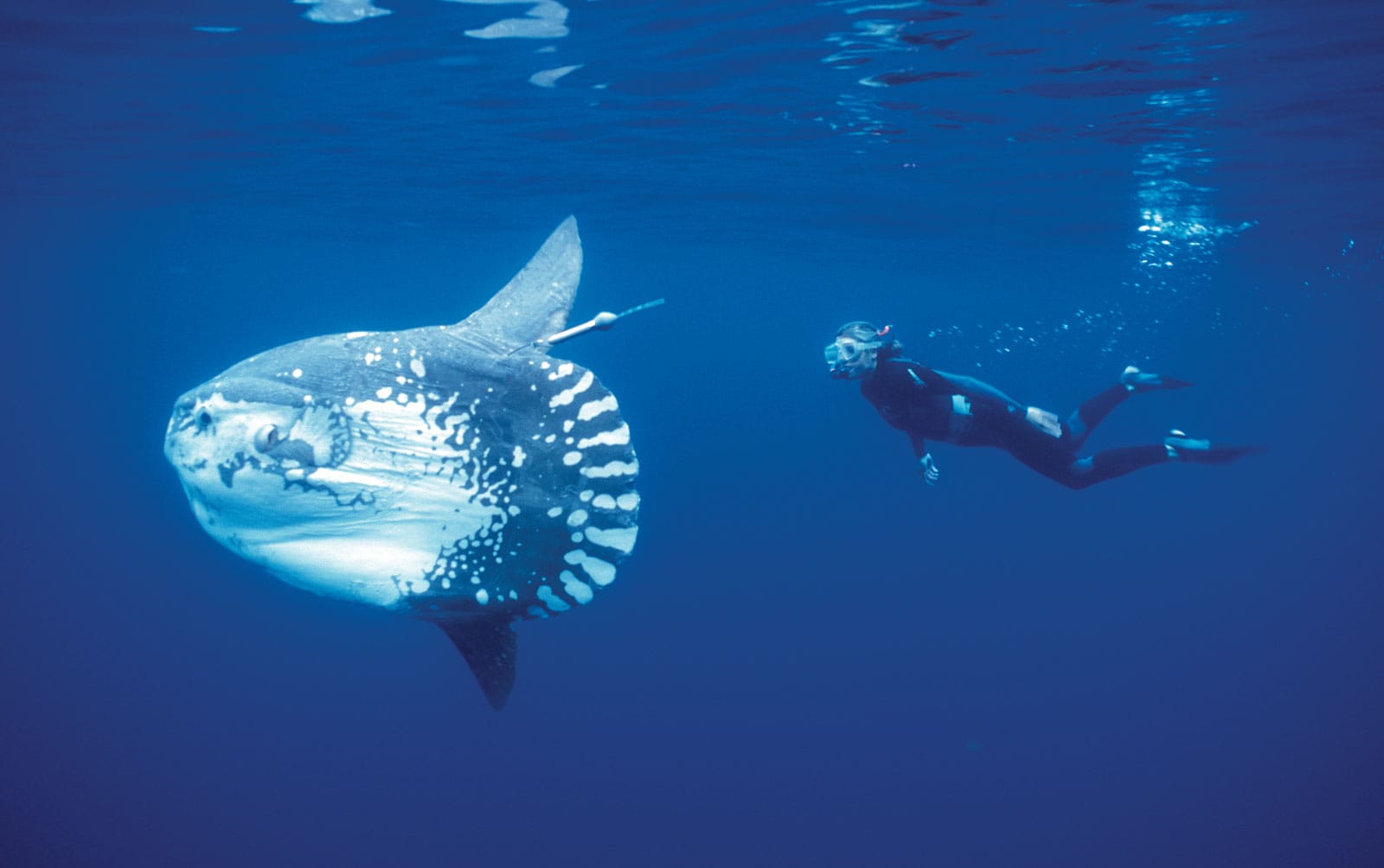Imagine a fish so massive, it looks more like a giant, swimming pancake than a traditional fish. That’s the ocean sunfish (Mola mola) – the world’s largest bony fish, and a creature full of surprises! This gentle giant, often spotted basking near the surface, enjoys soaking up the sun’s rays. This behavior sometimes leads to them being mistaken for sharks due to their pointy dorsal fins. However, these peaceful behemoths are far from predatory. Join us as we journey into the captivating world of the ocean sunfish, uncovering the truth behind the myths and discovering why these gentle giants deserve our admiration and protection.
Unmasking the Gentle Giant
The ocean sunfish (Mola mola), holder of the “largest bony fish” title, is a gentle giant inhabiting tropical and temperate waters worldwide. Reaching up to 14 feet (4.3 meters) from fin to fin and weighing as much as a car (up to 5,000 pounds), their size is truly awe-inspiring. But don’t let their massive size fool you; ocean sunfish are harmless to humans, posing more risk of boat collisions than bites.
Their diet mainly consists of jellyfish – imagine being the ocean’s biggest jelly enthusiast! They also consume zooplankton, small fish, and crustaceans. To protect themselves from jellyfish stings, mola mola have a specialized mucus lining in their stomachs.
A Body Built for the Open Ocean
Their unusual, flat bodies, resembling giant camouflage sheets, make them surprisingly inconspicuous in the vast blue. And while they lack a swim bladder—which helps most fish control their buoyancy—they’ve become masters of maneuvering those impressive dorsal and anal fins to navigate the ocean depths.
Ocean sunfish are known to bask at the surface, possibly for thermoregulation or to allow seabirds to remove parasites. They’ve even been known to leap out of the water, sometimes landing on boats.
A Reproductive Marvel
Speaking of impressive feats, female ocean sunfish are record holders in the egg-laying department! They can release a mind-boggling 300 million eggs at once—the highest fecundity of any vertebrate. Talk about being a fish mama! This reproductive strategy, known as pelagic spawning, involves releasing eggs and sperm into the open ocean for fertilization.
Facing the Challenges
Sadly, even with their impressive size and reproductive prowess, sunfish face a number of challenges. They’re often caught accidentally as bycatch, and their ocean home is under increasing pressure from pollution and habitat loss. This has placed them in a vulnerable position, but thankfully, researchers and conservationists are working hard to learn more about them and protect them for the future.
Unraveling the Mysteries
Often seen basking in the sun, the mola mola’s unique appearance and behaviors continue to fascinate scientists. The mola mola’s genome has been sequenced, providing insights into its unique biology. Researchers are continually studying their movements, diet, and reproductive habits using tagging and tracking methods.
The ocean sunfish is a perfect example of how nature constantly surprises us. It’s a reminder that the ocean is full of incredible creatures, each with a story to tell. So, the next time you think about the ocean’s giants, remember these gentle, sun-loving behemoths – they’re truly something special.
FAQs About Ocean Sunfish
Are Ocean Sunfish Poisonous?
No, ocean sunfish are not poisonous to humans. They lack venom glands or spines that could deliver toxins. They are gentle giants who pose no threat to humans, often showing curiosity towards divers rather than aggression.
Can You Eat Ocean Sunfish?
While ocean sunfish are considered a delicacy in some Asian countries, there are safety and ethical concerns to consider. Similar to other deep-sea fish, ocean sunfish can accumulate toxins in their bodies. These toxins could be harmful if consumed by humans.
Additionally, ocean sunfish are classified as “Vulnerable” by the IUCN, indicating their populations are at risk. Consuming a species already facing threats raises important ethical questions about our impact on their survival.
How Are Ocean Sunfish Born?
Ocean sunfish reproduce through pelagic spawning. The female releases millions of tiny eggs into the open ocean, which are then fertilized by the male’s sperm. The fertilized eggs hatch into small, transparent larvae that drift in the currents. Only a small fraction of these larvae survive to adulthood, highlighting the challenges they face in their early development.
What is Being Done to Protect Ocean Sunfish?
Conservation efforts for ocean sunfish focus on reducing fishing pressure, safeguarding critical habitats, and raising public awareness about their importance in the marine ecosystem. Some of the key initiatives include:
- Bycatch Reduction: Implementing fishing practices that minimize accidental catch of ocean sunfish in nets.
- Marine Protected Areas: Establishing zones where fishing is restricted to protect ocean sunfish and their prey.
- Research and Monitoring: Studying ocean sunfish populations, tracking their movements, and understanding their role in the ecosystem to inform conservation strategies.
- Public Education: Raising awareness about ocean sunfish, the threats they face, and the importance of their conservation.











